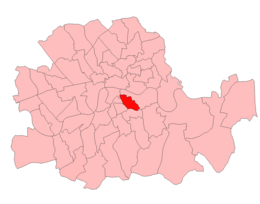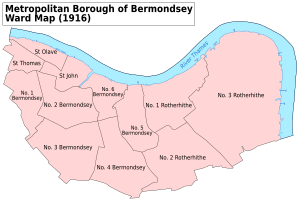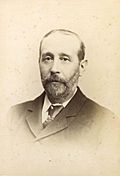Quick facts for kids {{{Name}}}
[[{{{Type}}} constituency]] |
[[Image:{{{Map1}}}Constituency.svg|120px|]]
[[Image:England{{{Map2}}}.svg|120px|]] |
| {{{Name}}} shown within [[{{{Entity}}}]], and {{{Entity}}} shown within England |
| Created: |
{{{Year}}} |
| MP: |
{{{MP}}} |
| Party: |
{{{Party}}} |
| Type: |
House of Commons |
| County: |
[[{{{County}}}]] |
| EP constituency: |
[[{{{EP}}} (European Parliament constituency)|{{{EP}}}]] |
Bermondsey West was a parliamentary constituency centred on the Bermondsey district of South London. It returned one Member of Parliament (MP) to the House of Commons of the Parliament of the United Kingdom.
The constituency was created for the 1918 general election and abolished for the 1950 general election.
Boundaries

Bermondsey West within London

The wards of Bermondsey Metropolitan Borough in 1916
The constituency, when it was created in 1918, comprised the wards numbered One, Two, Three and Four of the Metropolitan Borough of Bermondsey, in the County of London. This was the south-western part of the borough, and was similar in extent to the preceding Bermondsey Division of the parliamentary borough of Southwark.
It covered South Bermondsey ward and most of London Bridge & West Bermondsey ward, together with small sections of North Bermondsey, Chaucer and Old Kent Road wards, in the modern day London Borough of Southwark.
Members of Parliament
Election results
Election in the 1910s
*endorsed by Coalition Government
Election in the 1920s
| General election 1922: Bermondsey West |
| Party |
Candidate |
Votes |
% |
±% |
|
Labour |
Alfred Salter |
7,550 |
44.6 |
+26.0 |
|
Liberal |
Roderick Kedward |
5,225 |
30.9 |
-9.7 |
|
National Liberal |
Charles Richard Scriven |
2,814 |
16.6 |
-11.9 |
|
Ind U |
Charles Louis Nordon |
1,328 |
7.9 |
New |
| Majority |
2,325 |
13.7 |
N/A |
| Turnout |
26,168 |
64.6 |
+19.1 |
|
Labour gain from Liberal |
Swing |
+17.9 |
|
| General election 1929: Bermondsey West |
| Party |
Candidate |
Votes |
% |
±% |
|
Labour |
Alfred Salter |
13,231 |
60.2 |
+3.0 |
|
Liberal |
Leonard Stein |
4,865 |
22.2 |
-20.6 |
|
Unionist |
Herbert Cecil Butcher |
3,852 |
17.6 |
New |
| Majority |
8,366 |
38.0 |
+23.6 |
| Turnout |
32,963 |
66.6 |
-8.4 |
|
Labour hold |
Swing |
+11.8 |
|
Election in the 1930s
| General election 1931: Bermondsey West |
| Party |
Candidate |
Votes |
% |
±% |
|
Labour |
Alfred Salter |
10,039 |
48.1 |
-12.1 |
|
Conservative |
Norman Bower |
9,948 |
47.7 |
+30.1 |
|
Communist |
Wal Hannington |
873 |
4.2 |
New |
| Majority |
91 |
0.4 |
-37.6 |
| Turnout |
32,904 |
63.4 |
-3.2 |
|
Labour hold |
Swing |
-21.6 |
|
| General election 1935: Bermondsey West |
| Party |
Candidate |
Votes |
% |
±% |
|
Labour |
Alfred Salter |
12,603 |
62.2 |
+14.1 |
|
National Liberal |
Francis Rainault Abbott Glanville |
7,674 |
37.8 |
-9.9 |
| Majority |
4,929 |
24.4 |
+24.0 |
| Turnout |
30,803 |
65.8 |
+2.4 |
|
Labour hold |
Swing |
N/A |
|
- Glanville was a son of the former MP Harold Glanville. Conservative candidate Francis Howard Collier withdrew when Glanville gave an undertaking to support the National Government.
Election in the 1940s
| General election 1945: Bermondsey West |
| Party |
Candidate |
Votes |
% |
±% |
|
Labour |
Richard Sargood |
8,139 |
72.2 |
+10.0 |
|
National Liberal |
W. Bernard Pemberton |
2,238 |
19.8 |
-18.0 |
|
Liberal |
Francis Howard Collier |
903 |
8.0 |
New |
| Majority |
5,901 |
52.4 |
+28.0 |
| Turnout |
17,004 |
66.3 |
+0.5 |
|
Labour hold |
Swing |
+14.0 |
|




